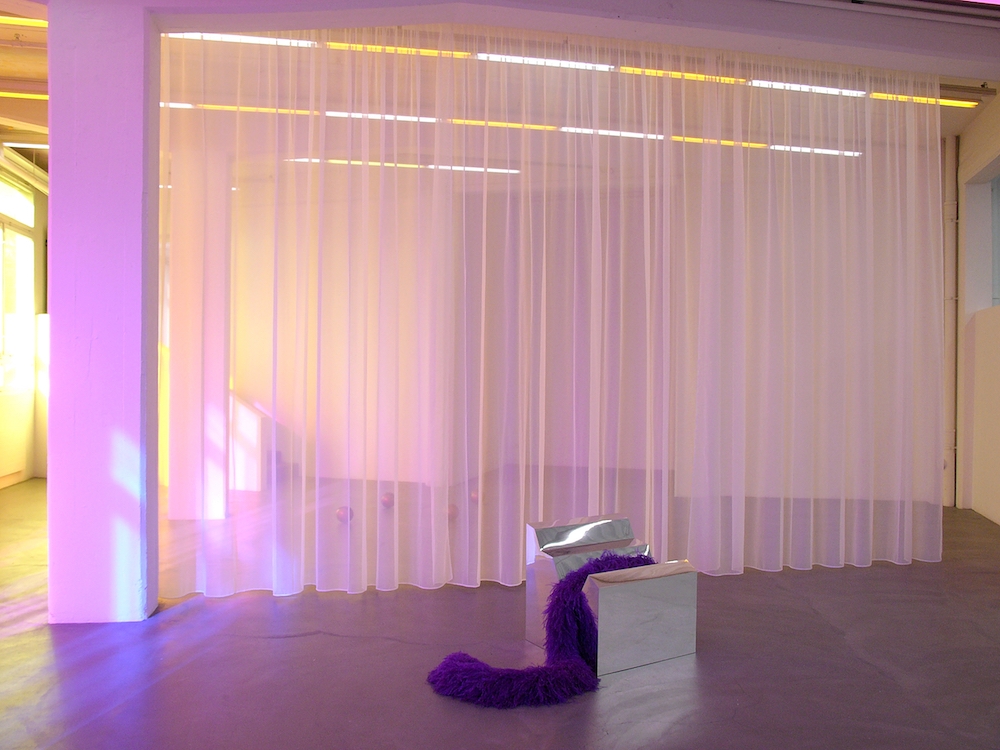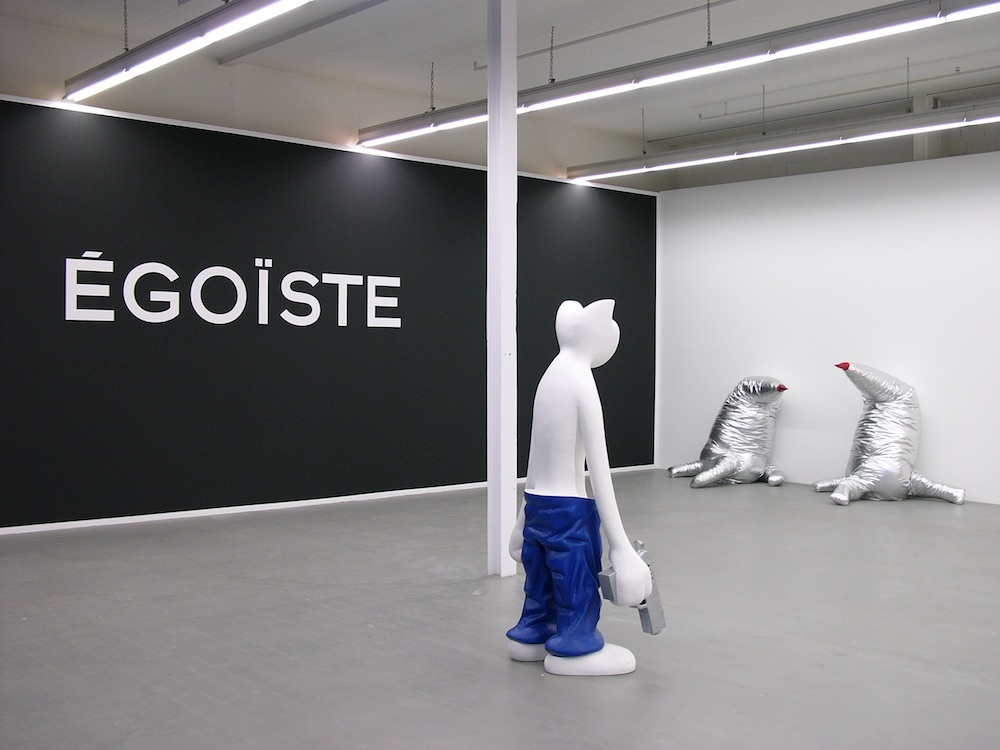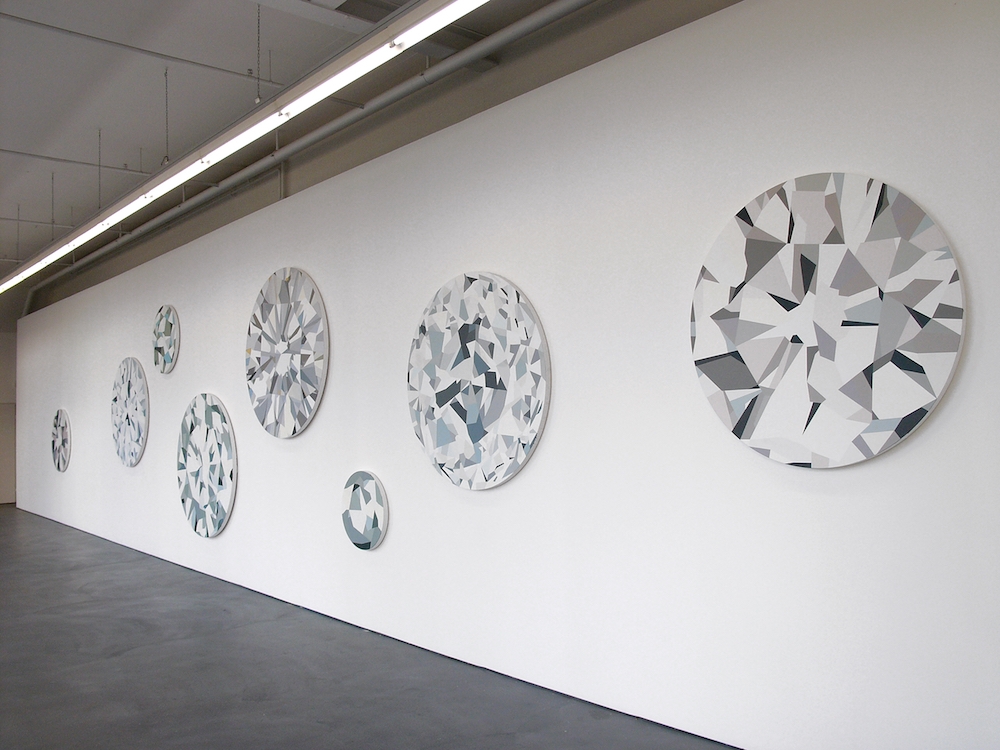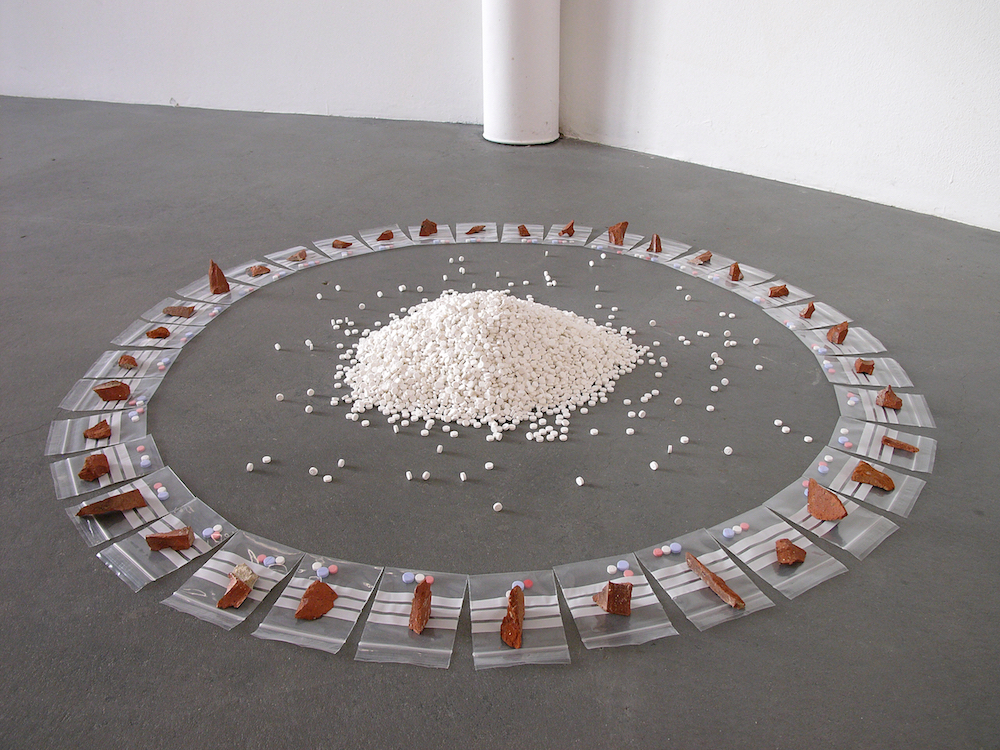Midnight Walkers
21.1. —
26.3.2006
With the exhibition Midnight Walkers, the curators of both venues, Kunsthaus Baselland and Le Credac, i.e. Sabine Schaschl-Cooper and Claire Le Restif, have engaged in a special type of cooperation. On the one hand, the architectural and geographic conditions prevailing in both institutions play a role — both Kunsthaus Baselland and Le Credac are situated in urban peripheries and are, either partly or in their entirety, characterized by their ‘underground architecture’.
On the other hand, the heritage of the French group of Situationists (active between 1957 and 1972) was taken as a conceptual point of departure, emphasis being placed on the act of roaming the city, on immersing oneself in whatever it has to offer, and on ‘going with the flow’. The city and its secret peripheries were discovered and described by the Situationists as places of intense social and political conflicts. Everyday discoveries, drifting through the city with the purpose of getting a real, unadulterated taste of it also form the basis of contemporary artistic creations. Against this backdrop, the exhibition Midnight Walkers perceives itself as a romantic, synthetic, and fictitious landscape in which nocturnal roving implies a searching, melancholy, pensive, but also ironic and humoristic mood in harmony with one’s living conditions. The cooperation between Kunsthaus Baselland and Le Credac is founded on the mutual appreciation of their curatorial work, and on the interest evinced in the artworks that have been on display in one, but not both, institutions. The shows revolve around works created by artists from France as well as from French- and German-speaking Switzerland. The two exhibitions, while differing in their spatial setup, methodology, and the art they offer, engage in a cross-border dialogue that will result in a joint publication.
The oeuvre of Saâdane Afif, who was born in 1970 and lives in Paris, is marked by strategies circumscribing the art and music world; it challenges the notion of ‘interpreting’ and employs the appropriation technique provided it matches the overall concept of an exhibition in which he takes part. For four different exhibition projects, Afif has asked art critics Tim Morton, Lili Reynaud-Dewar, Mick Peter, and Maxime Matray to write lyrics, to be subsequently turned into songs by musicians in line with the given exhibition project. Every song relates to a certain object/project, and has also been used by the artist as a title for the latter. For the show Midnight Walkers, the curator has selected cuts from existing music albums, to be pinned onto the wall as written documents. Afif also makes use of the Kunsthaus Baselland infrastructure, incorporating existing benches into an installation with a view to inviting viewers to listen to individual pieces of music by means of headsets. A recurrent work in Afif’s oeuvre alludes to French artist André Cadere, who in 1970 created the Barre de bois, a stick consisting of a vertical sequence of multi-colored painted wooden rings. Cadere traveled through Europe and to New York with his sticks, where he was seen grasping them either as a walking cane or depositing them at selected sites. Similarly to Cadere, whose goal was to trigger discussions about the art scene by means of his actions, Afif intends to continuously question artistic authorship and system functions by reusing Cadere’s invention.

The point of departure in the oeuvre of Delphine Coindet, who was born in 1969 and lives and works in Paris, is a digitally created design of spatial scenarios which the artist translates into reality. Her virtual computer drawings, boasting an artificial colorfulness, are done in a site-specific manner, i.e. they are adapted to individual exhibition projects. On this basis she creates objects and sculptural constellations, frequently hybrids hovering between architectural, designed, and theatrical forms. Delphine Coindet attempts to “redefine the status of the work, going beyond any significance of use” (Hauviette Bethemont). In the exhibition Midnight Walkers her two pieces On Edge and Les Grelots are staged anew in a site-specific fashion. A curtain picks up the theme of spatial separation achieved by pillars while it also connects the two works placed in front and in the back thanks to its transparency. The five-part window front is imbued with different nuances of color, investing the overall presentation with an ‘off-standard’ midnight touch. The violet feather boa, draped across an undefined mirror object, corresponds with the purple color filters placed on the windows; Coindet’s oversized sleigh bells, or grelots, suggest joy and celebration. Her virtual model, however, renders such associations less immediate. Viewers eventually perceive something oscillating between reality and fiction.
Annelise Coste, who was born in 1973 and lives and works in Zurich, has made a name for herself mainly with her small-format as well as poster-sized drawings, articulating herself by means of spraying cans and verbally, as well as by scribbling and drawing expressive elements, both figured and abstract in nature. The artist also resorts to several other media such as performances, bricolage objects, poems, and photography. For the show Coste has selected a number of digital photos which, printed by applying a plotting technique, capture intimate midnight moments spent with her girlfriend. There is a connection between photographs and drawings — the artist frequently raises existential questions, articulating them by writing words, choosing colors, or executing gestures in her drawings or photos in the form of direct statements that expose every single pore. The connection is equally implied by ‘emotional messages’ which she sends out to the world” (Nadja Schneider). Her series of photographs is to be understood as such.
In her painting, Sylvie Fanchon, who was born in 1953 and lives and works in Paris, taps the abstract potential of real things such as maps, schematics, plans, clouds, etc. She removes them from their usual context and places them in the hybridity between the figurative and the abstract. At first sight, her paintings appear simple: comic-style balloons here, a few splashes of color there, molecular formations in one picture and art-historical brushstroke references in another. The sequence of pictures is reminiscent of comic-strips that viewers want to read like a narrative. Gradually, however, they become aware that what seems to be a narration is, in fact, just the figment of their imagination. The potentially narrative allows viewers to enter Fanchon’s complex realm of painting in which there is neither a beginning nor an end, neither three-dimensionality nor order nor coincidence. The power of her works is derived from their capacity to generate a ‘personality’, to be construed as humorous, pensive, or even ‘malicious’. “A picture is like a piece of my brain, pictures are like chunks of thoughts or stand-ins for these thoughts,” says the artist.

Sylvie Fleury was born in 1961 and lives in Geneva. Her art unfolds in the universe of fashion, glamour, and luxury commodities. Nevertheless, in her objects, installations, pictures, and mural paintings the world of consumption and affluence is not asserted but ironically commented on. Time and again, this results in the expression of post-feminist views. She works with symbols of masculinity such as cars (in a smashed state) and applies lipstick colors to them, or she destabilizes rockets by changing their original surfaces, i.e. their nature, color, ‘order’, and ‘representation’. Her Soft Rockets play with the idea of ‘masculinity gone soft’; their golden or silver color, for all its connotation of luxury, cannot conceal their dysfunction or inefficacy. With her mural Egoïste, Fleury alludes to a perfume by Chanel designed to tout selfishness as a positive male quality. As a large-format statement placed on a wall, the original idea is ‘expanded’ in every interpretative direction, and because it is literally ‘blown out of proportion’ it eventually collapses.
For all their simple projection, the two films Scratch and Holepunch by Amy Granat, who was born in 1976 and lives and works in New York, have a physical impact on spaces and viewers. Amy Granat is a founding member of the experimental filmmakers’ group Cinema Zero, devoted to the legacy of experimental films as well as their contemporary promotion. In Scratch the physical scratches in film are transferred into a large-format projection. “There is an interestingly incongruous relationship between the small gesture of scratching the minute film frames paired with the larger, immediate and in-your-face projection that results,” comments Richard Aldrich. Space, light, sound, and film are always integral parts of Granat’s art. In her installation Scratch there is a projection onto three black canvasses such that the viewer becomes fully immersed in them. The sound emphasizes the scratching noise. Individual lines on the surface, flickering white, merge and swell into a concert directed at our eyes and bodies; the sound is also directed at the capacity to hear. Holepunch too works in this way. Two films, whose raw material has been punched and which are projected onto a corner by two beamers, seem to be permanently knocked from left to right and pushed from the top to the bottom. The sound reinforces the impression of something impacting and rebounding. Even though the two films, as suggested by their titles, conjure up hardness, something ‘beating’ and ‘scratching’, they harbor poetic moments, and in this duality they bear a resemblance to La Monte Young, Velvet Underground, or Cy Twombly’s paintings (Aldrich).

In his work Mathieu Mercier, who was born in 1970 and lives and works in Paris, takes an interest in several phenomena. He explores the relationship between architecture, design, and art (both contemporary and historical,such as Mondrian). Additionally, he picks up everyday things, modifying and confronting them with a discourse on modernity. For this exhibition Mercier produced three birdcages, reminiscent of handmade structures of tangled wire; but on account of their technical perfection they appear to be design objects. The cages house a pair of budgerigars. The windows in the exhibition room provide them with an unrestricted view of their original habitat in which, alas, they no longer live. The second work features a series of circular paintings whose composition reminds us of cut diamonds or, generally, pieces of jewelry. In the exhibition context, the work conjures up the notion of being ‘trapped’ in a world of luxury items, a feeling of being torn between a free and a closed-off world, as well as the setting of mental borders colliding with reality.
The art of Olivier Mosset, who was born in 1944 and lives and works in Tuscon/Arizona, has been examined from very different vantage points. Roland Wäspe and Yves Aupetitallot have stated this in the preface to Mosset’s most recent catalogue: “Olivier Mosset’s art is a persistent search for a form of metaphorical truth. It is associated with the reductionist program of BMPR and monochrome Radical Painting, as well as with the appropriative tendencies of the Neo-Geo movement — maybe because it is targeted so consistently at the material conditions of the painting (dimensions, format, substrate, color, application of colors, etc.). His art has been viewed from different perspectives of art critique and art theory, and connected to diverse artistic movements, to American, French, or Swiss tendencies. Mosset’s oeuvre, to put it in a nutshell, is embedded in a multitude of complementary and occasionally also contradictory contexts.” A grey wall, which starts at a height of 1.40 meters and follows prevailing architectural conditions, may mean several things: A contribution to discussions about abstraction or an integration into an exhibition environment, i.e. being able to act as background and foreground at the same time — in other words, being flexible and open to everything
Markus Augustinus Müller, who was born in 1970 and lives and works in Basel, creates sculptures that occupy the intermediate space of Baroque décor and theater props which he transposes into an art discourse. At first sight, many of his sculptures, due to their surface qualities, pretend to embrace a mimetic attitude. A table, for example, appears to be made of marble, and oversized agates look like real semiprecious stones. Upon closer inspection, however, an entirely different quality becomes evident. The artist reveals that the surface pretends to be something it is not. A case in point is the sculpture presented at this show: It is not a rock crevice positioned on a structure made of round logs attached to each other. It is an assembly of milled, painted wooden boards that are arranged one after the other on a scaffolding made of wooden planks. Müller plays with the gap between presentation and representation, between fact and fiction, between ‘poor’ materials and luxurious surfaces.
For Florence Paradeis, who was born in 1964 and lives and works in Paris, there are two types of pictures: pictures capturing moments which have been experienced, read, heard, or dreamed, and pictures that are ‘artificially’ designed. Her photographs allude strongly to cinema, frequently evoking film frames frozen in time. The photo Le Baiser, which is featured as a large-format poster in the exhibition, is reminiscent of well-known film scenes in which a man and a woman engage in a kiss. But here, the woman looks at her partner with open eyes, and the picture exudes an air of insecurity. Something is not the way it ought to be. A moment of intimacy involving two people comes to an abrupt halt, and a third person — the viewer — joins the scene. This uncanny feeling of unease is augmented by the golden ring the woman has on her finger: it symbolizes a skull wearing a top-hat. The sky heralding nightfall reinforces an atmosphere marked by yearning and melancholy; it seems to usher in both the end and a new beginning of a love affair.

Frédéric Post, who was born in 1976 and lives and works in Geneva, is the ‘squatter’ among the artists involved in Midnight Walkers. His flag designs complement the music labels of various underground bands with invented elements. A black flag sports a round hole in the middle, bearing a resemblance to records. Perched on a balcony-like projection in Kunsthaus Baselland, it confronts the works surrounding it with its revolutionary aura. At various locations in the exhibition area, Post has positioned ‘tablet heaps’, and he calls each individual tablet a ‘mini-sculpture’. These placebos are marked on their surface with three elevated dots that can be traced back, as Post implies, to the ‘bad boys’ sign of 1960s youth gangs. Members of these gangs had three dots tattooed between their index finger and thumb so as to express their willingness to be ‘bad’. Post, who distributes these placebos across the exhibition space and arranges tablets placed in small bags around them, invests the show with an atmosphere that articulates the late-night consumption of pharmaceuticals as well as their danger, the taboos conjured up by them, and the longing to escape reality.
Didier Rittener, who was born in 1969 and lives and works in Lausanne, is first and foremost interested in the production of contemporary images that have turned into visual mass-media entities. He takes pictures out of newspapers, magazines, sample books, art catalogues, and literary works by employing a special chemical method. Subsequently, he manipulates their size and applies them to different surfaces. This approach allows him to generate unique but differently structured copies, as well as to manipulate and add them to other pictorial fragments, thereby giving rise to new images. Also with his sculptures, Rittener creates new forms of a picture collection compiled over the years, resembling a private picture archives. His star-shaped sculptures arranged in spatial formations remind viewers of schematics of stars translated into three-dimensionality, but there are also similarities to the tradition of geometrical sculpting. Resembling atavistic elements, Rittener’s sculptures and his so-called ‘picture transfers’ are reminiscent of customary pictorial features. Their transposition into new contexts makes them appear both strange and familiar.
Alain Séchas, who was born in 1955 and lives and works in Paris, is obsessed with the presentation of cats. This monothematic approach has liberated him insofar as his artistic creation is not solely focused on form but also on content and atmosphere. Cats, as a sculptural unit, are thus able to reflect every conceivable human situation with all its humoristic and ironic twists and turns, as well as every conceivable social situation. Séchas places his sculptures in front of pictures that serve as a background to events featuring cat figures. La Monitrice, or female skiing instructor, is a three-dimensional sculpture with swaying sexy hips in front of a landscape on canvas dotted by sheep observing it. In contrast, Une grande bêtise shows a male cat wearing slightly pulled-down pants and having a pistol in its paw, about to do something really stupid, as implied by the title and the background painting. Alain Séchas’s art makes viewers feel very close to it, and they find it almost impossible to evade the physical impact the felines have on them. There is a suggestion of a narration that immediately involves the viewer. Jimmy Hendrix’s “Hey Joe I heard you shot your woman down” comes to mind when looking at La grande bêtise, but things might not have been as bad as implied by what seems to be unfolding in front of this midnight blue surrounding the spatial installation.